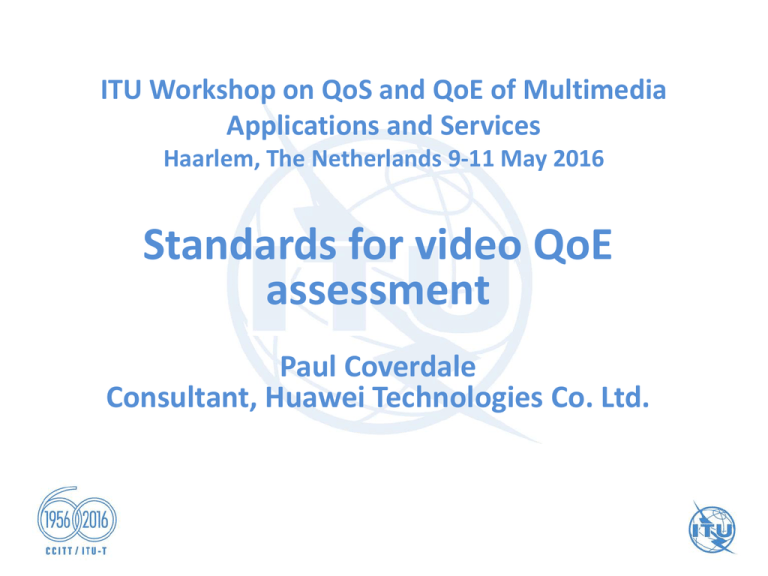Standards for video QoE assessment Paul Coverdale Consultant, Huawei Technologies Co. Ltd.
advertisement

ITU Workshop on QoS and QoE of Multimedia Applications and Services Haarlem, The Netherlands 9-11 May 2016 Standards for video QoE assessment Paul Coverdale Consultant, Huawei Technologies Co. Ltd. Methodologies for assessing video QoE • In principle, assessment of video Quality of Experience (QoE) must be performed using subjective tests, with metrics such as the mean opinion score (MOS) • However, it is also possible to estimate QoE based on objective measurement of key parameters, and associated quality estimation models 2 Subjective testing • Subjective testing needs more resources and effort because it requires human subjects, and is not so convenient in a live-service setting 3 Objective measurement and QoE calculation • Objective measurement and QoE calculation is generally much faster and more convenient, especially in a live-service environment, but the accuracy of the QoE estimation depends on the complexity of the models, and an understanding of the important human factors 4 Application of video QoE assessment methodologies • Planning – refers to estimating the QoE of networks/systems before they are implemented. Since it is not used in a real-time environment, no real-time inputs are required to the objective model. Accuracy of quality estimation is generally more of a concern than computational complexity. • Lab-testing – refers to estimating the QoE of networks/systems in the laboratory while the equipment is being developed. Requires real-time inputs. Accuracy of quality estimation is generally more of a concern than computational complexity. • Monitoring – refers to estimating the quality of experience of networks/systems that are operational. Requires real-time inputs. Trade-off between accuracy of quality estimation and computational complexity. 5 Types of objective video QoE assessment models There are five different types of objective video QoE assessment models: • Media-layer (Perceptual) models – The input to the model is the media itself (the video signal). – 3 basic approaches for gaining access to the media • Full-Reference (FR) (also known as intrusive, active, double-ended) • No Reference (RR) (also known as non-intrusive, passive, singleended) • Reduced Reference (RR) 6 Types of objective video QoE assessment models • Packet-layer (Parametric) models. – The input to the model is information derived from the packet stream and client state information. A parametric model also needs additional sideinformation such as codec type and bit-rate. • Bitstream-layer models. – The input to the model is information derived from the bit-stream and other packet information. Possible input is also client state information. 7 Types of objective video QoE assessment models • Hybrid models. – The input to the model is the media and the bitstream. Possibly also general packet information and client state information. • Planning models – The input to the model includes the quality planning parameters of networks or terminals. It usually requires prior knowledge about the system under test. 8 Existing ITU-T video QoE Standards (from Rec. G.1011) Application Media Conversational (CONV)/Nonconversational (NONCONV) Subjective test methodology NONCONV [ITU-T P.1302] CONV [ITU-T P.920] [ITU-T P.1301] Objective test methodology Model FR/RR/NR Primary usage NR PLN Video telephony Multimedia [ITUT G.1070] (NB/WB) Important to have a unique standardised model for a given application, to avoid having different QoE estimates 9 Existing ITU-T video QoE Standards Application Media Conversational (CONV)/Nonconversational (NONCONV) Subjective test methodology Model FR/RR/NR Primary usage FR LAB, MON RR MON FR/RR MON/PLN NR MON [ITU-T J.144] (SD) [ITU-T P.910] Video NONCONV [ITU-T J.140] [ITU-R BT.50013] [ITU-T J.247] (QCIF, CIF, VGA) [ITU-T J.341] (HD) [ITU-T J.249] (SD) [ITU-T J.246] (QCIF, CIF, VGA) [ITU-T J.342] (HD) [ITU-T P.830] Video streaming (Mobile TV/IPTV) Audio NONCONV [ITU-R BS.11163] [ITU-R BS.1285] [ITU-R BS.1387] [ITU-R BS.15342] [ITU-T P.1201.1] (QCIF, QVGA, HVGA) Multimedia NONCONV [ITU-T P.911] 10 [ITU-T P.1201.2] (SD, HD) [ITU-T P.1202.1] (QCIF, QVGA, HVGA) [ITU-T P.1202.2] (SD, Current video QoE work items in SG12 • P.NATS – Parametric non-intrusive assessment of TCP-based multimedia streaming quality, considering adaptive streaming • G.OM_HEVC – Opinion model for network planning of High Efficiency Video Coding (HEVC) media streaming quality • G.vidmos – Guidelines for [selecting/choosing] models for assessing video quality 11 P.NATS - Scope • P.NATS is a collection of objective parametric quality assessment modules that predict the impact of IP network impairments on QoE in multi-media mobile streaming and fixed network applications using progressive download, including adaptive streaming methods. • Four modes of operation are defined to cover a range of use-cases from monitoring streams where the video is fully encrypted through to unencrypted streams where there are no limitations on processing power available. 12 P.NATS - Architecture Media parameter extraction O.21 O.22 Pq: Integration I.13 Buffer parameter extraction Stream I.01 Pa: Audio cod. Quality I.11 impact Pav: A/V integration/tempo ral Pv: Video cod. Quality impact Pb: Stalling quality impact I.14 Diagnostic information Input-level 13 O.34 O.35 O.46 O.23 integral MOS G.OM_HEVC - Scope • Network planning model which estimates the impact of IP network impairments on QoE in video applications using HEVC (H.265) coding over transport formats such as: RTP (over UDP), MPEG2-TS (over UDP or RTP/UDP). • Extension of existing Rec. G.1071 “Opinion model for network planning of video and audio streaming applications” 14 G.OM_HEVC -Architecture 15 G.OM_HEVC – Modules Module name Description Developing consideration Subjective tests requirements Pa Audio module G.1071-HR audio module No Pv1 blockiness module main focus Pv2 bluriness module Update of G.1071-HR parameters and coefficients Module not available in G.1071 Update of P.NATS mode 0 formula? Pv3 jerkiness module Not available in G.1071-HR a few testing cases secondary focus; some testing cases Update of G.1071-LR or P.NATS mode 0 formula? Pv Pq Note: Module useful for use of G.OM_HEVC in TCP context (Q14) Yes Pv4 slicing module Update of G.1071-HR parameters and coefficients main focus Pv5 freezing module G.1071-HR freezing module 1 or 2 testing cases (anchors) for alignment with G.1071-HR Audiovisual module G.1071-HR audiovisual module 16 Yes (to validate formula) G.vidMOS - Scope • Aim is to provide a global view of video QoE assessment and the relation between video QoE related Recommendations • Provides guidelines on how to choose the relevant Recommendation as an implementation reference according to different scenarios • Will also include definitions of metrics which are used in video QoE models 17
